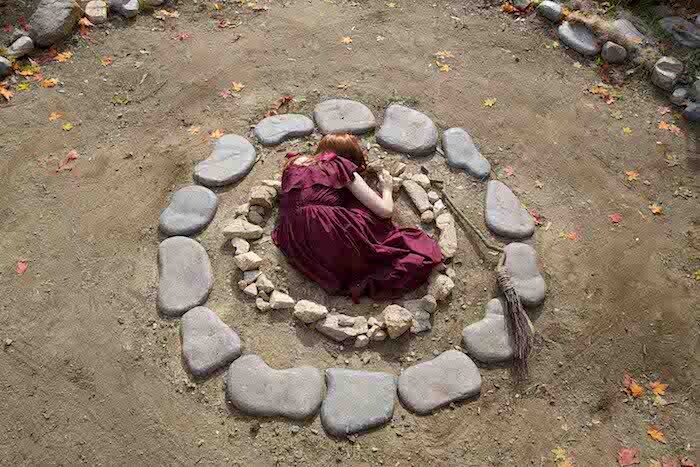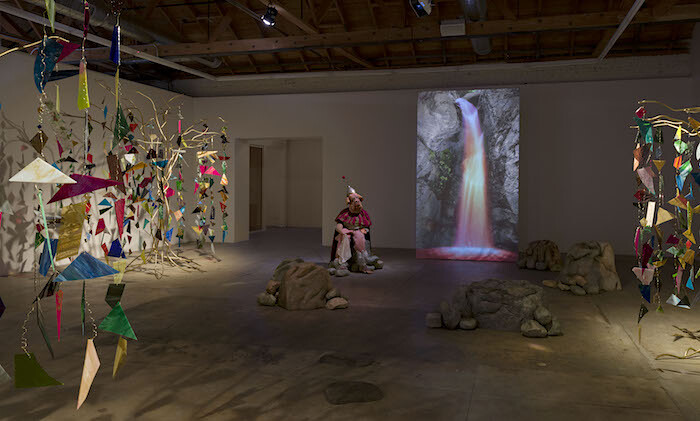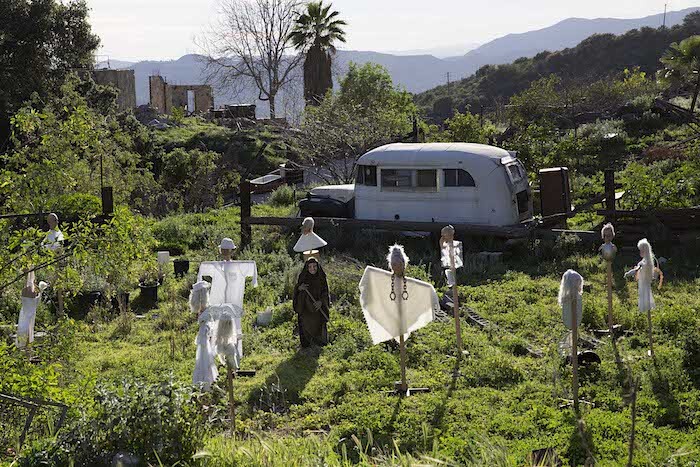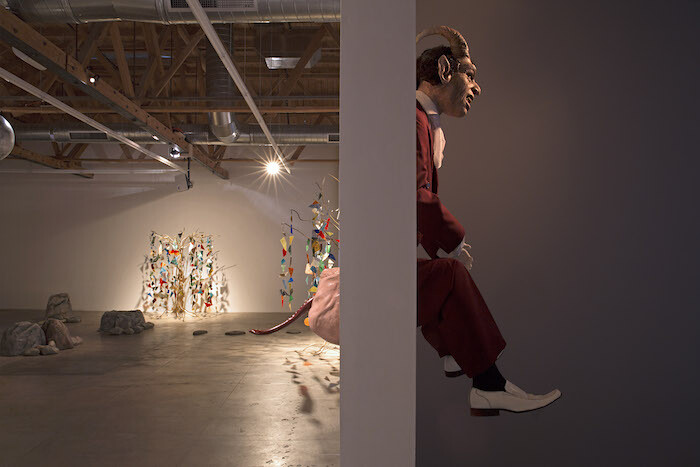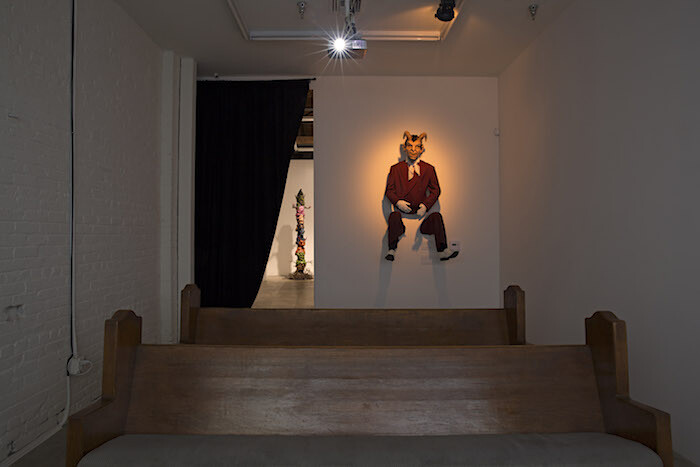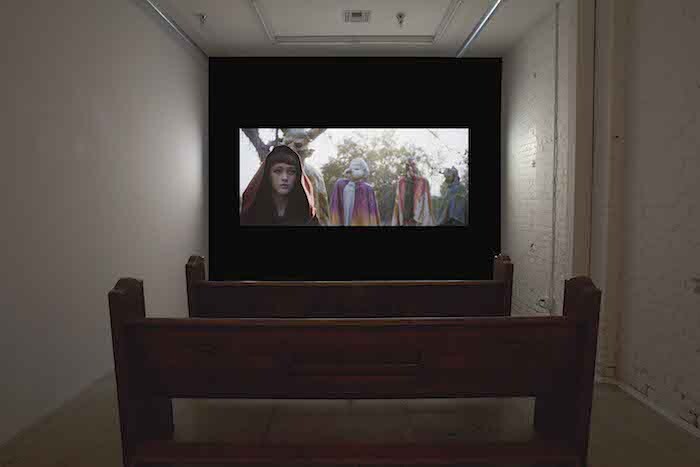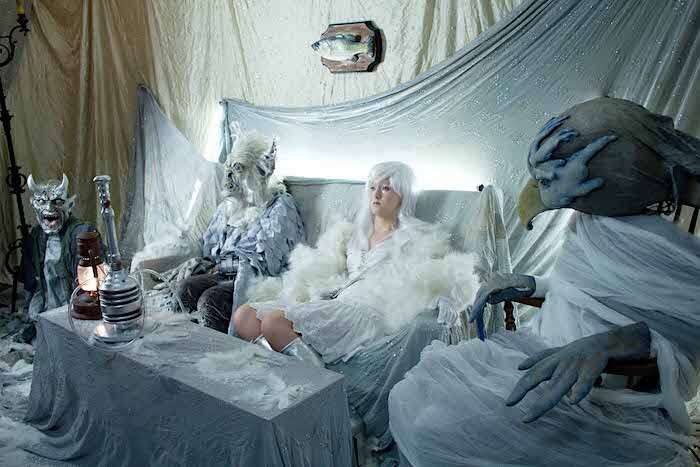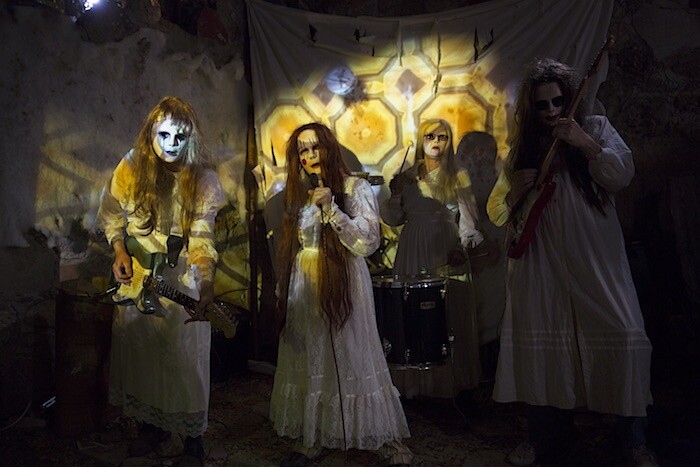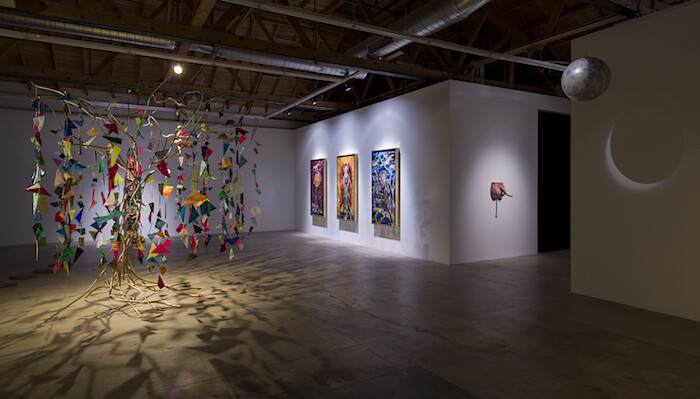During the day, Halloween masks look pretty cheesy. Hanging from the drugstore rack’s seasonal aisle under the terrible clarity of fluorescents and the afternoon sun, it’s hard to image these killer clowns and fat-cheeked Frankensteins frightening anyone. Their warped faces and weeping pustules, yellowed horns and sharpened teeth, all a static, cartoonish fakeness crinkling in the soft latex.
But they do frighten, only in the right place. Or better yet, they let fright happen.
Night shadows make those masks less costume and more possibility, the cheap details worn away with the darkness. The contrivances of Halloween allow for the playacting of fear and violence, a space and costume to exorcise one’s inner demons by becoming them. And besides all that, the freaks come out at night. Who makes a monster? The feared, the outcast, the othered. Most of us find easier affinity with the monsters than with the pitchforked mob that sometimes chases them.
In the darkened gallery at Gavlak, Marnie Weber gathers a coterie of monsters with stacked Halloween masks under a weeping willow dangling shards of stained glass. Along the walls hang a suite of pagan collages and through a dark doorway church pews face a screening of the artist’s first feature-length film. The collages resemble the paintings in Disneyland’s Haunted House: a bit grim, a bit fantastical, and depending on how or when you seem them, either ghoulish or tacky. Perhaps charmingly both.
Weber’s particular aesthetic emerges from the specific subgenres of punk that took costumes to be avatars. A dress-up beyond the idle S&M of Vivienne Westwood’s Seditionaries, bands like the Cramps and Misfits stole the proto-punk face-paint of Alice Cooper and wedded it to B-movie, sci-fi, and horror, a combination of shriek and schtick that birthed a mutant litter of submovements from psychobilly to darkwave. Emerging from underground music in the 1970s and 80s, Weber adds the old-timey and vaudevillian to her performances, installations, objects, and films to make her very own haunted hayride.
The central piece in this outing is the movie, called The Day of Forevermore (2016). Here, monsters lounging at home in the afternoon manage to embarrass one of their less monstrous offspring. Starring Weber’s (and artist/partner Jim Shaw’s) teenage daughter, Colette Weber Shaw, named here Luna Crimson, the movie tells a fairy-tale-ish coming-of-age story. Crimson’s alcoholic crone witch-mother (played enmasked by Weber) and her cohort of monsters live on a ramshackle supernatural ranch/junkyard called Forevermore Acres. This turns out to be all totally embarrassing to Luna once she befriends some average suburban kids off-ranch and invites them to dinner in her hut (mom serves rump roast, the steaming ass of a devil). Confronted with the lure of the normal versus a sense of responsibility to the weirdos, Luna attired like a fairytale maiden largely declaims, flies kites, and bites her lip in quiet mortification under the daybright sun.
But night is where monsters belong. The dream and shadow of the evening, the poetry of a world composed of outsiders free to slink through the world whilst others sleep. In two nighttime scenes in Forevermore, a long opening tableau vivant and a late-night punk bar, all the monsters look exactly right, belonging as they do to the darkness. At the bar, a coterie of masked and warped witches lose their false theatricality and take on the deepened lure of legend, female power. The latex cheesiness of their masks falls away and they become creatures of the night, celebratory in their special haven. As one of the few scenes not shot in a first-person limited around Luna, it’s also a scene that doesn’t feel stiffly self-conscious of its teenage self.
In the Forevermore, the monstrous becomes a kind of metaphor for the possibilities of imagination lasting into adulthood through art and underground culture as well as how terribly corny artful dreams can look through the eyes of our suspicious teenage children. The B-movie schlock of horror punk liberated its acolytes, creating a place to act out trauma and aggression—where negative feelings, painted in makeup, could transform into the possibility of low glamour and, like all punk, a community to share that in. Misfits together carve out of the world, a special space for each other. Their children can keep with the outsiders and weirdos or look out there for some semblance of normalcy, as Luna is forced to choose.
The monsters of Forevermore don’t seem to be going out to frighten anyone. No innocent children are lured into pots. No one murders feckless naked blondes with cowardly boyfriends. There are perhaps some substance abuse problems and the occasional devil’s ass served up for supper, but they mostly just look like monsters. Seeing the monstrous denizens of Forevermore Acres gathered over strange brews at their fiendish late-night punk bar, Weber’s longtime band the Spirit Girls playing behind them, it felt rather normal to me, something I can imagine happening every night in some dark corner of Los Angeles. Becostumed weirdos and witches gathering to gossip about their own over cocktails. I might even do this rather regularly.
Halloween in lore is the time when the boundary between the spirit world and reality is permeable. The tradition of giving out candy began as a way to let the spirits of the dead know that they were still welcome, with these treats as offerings. The masks allow us to invoke the dead, the visual horror of our fears and tragedies, the deepest reaches of our psyche under the guise of the playful. But raw freedom and refined mischief are still there, and in this place unstuck from reality even a latex mask can become both frightening and freeing. Fantasy isn’t an escape from reality, but a safe space in which to make conscious the unconscionable. There’s room for every monster in Forevermore. In her long practice, Weber finds a fold for every freak as well as their children.

